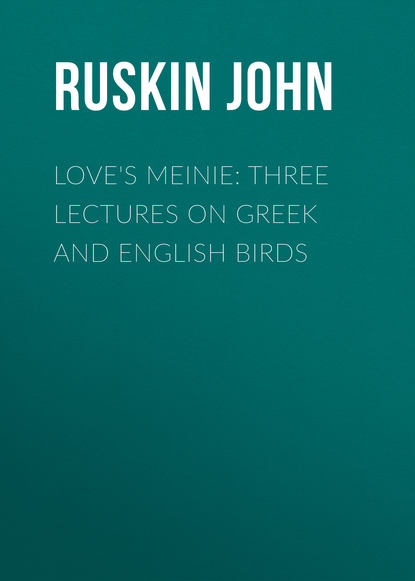По всем вопросам обращайтесь на: info@litportal.ru
(©) 2003-2024.
✖
Love's Meinie: Three Lectures on Greek and English Birds
Автор
Год написания книги
2018
Настройки чтения
Размер шрифта
Высота строк
Поля
149. ALLEGRETTA NYMPHÆA. LILY-OUZEL
Var. 1 (IX.A.)
ALLEGRETTA NYMPHÆA, MACULATA. SPOTTED ALLEGRET
Rallus Porzana. L.
Poule d'Eau Maronette. F.
Winkernell. T.
rzana. I.
Zapornia Porzana. G.
Crex Porzana. Y.
Ortygometra Porzana. Steph.
Gallinula Maculata et Punctata. Brehmen.
Spotted Crake. B.
The 'Winkernell' is I believe provincial (Alsace); so, Girardina, Milanese, and Girardine, Picard.—I can make nothing whatever of any of these names;—Porzana, Bolognese and Venetian, might perhaps mean Piggy-bird; and Ortygometra Porzana would then mean, in serious English, the 'Quail-sized Pig-bird.' I am sorry not to be able to do better as Interpreter for my scientific friends.
IX.B
ALLEGRETTA NYMPHÆA, STELLARIS. STARRY ALLEGRET
Not separated by Linnæus, or Buffon, or Bewick, nor by popular German or French names, from the Marouette.
Crex Baillonii, Baillon's Crake. Y.
Porzana Pygmæa. G.
Gallinula Stellaris. Temminck.
IX.C
ALLEGRETTA NYMPHÆA, MINUTA. TINY ALLEGRET
Porzana Minuta, Olivaceous Crake. G.
Crex Pusilla, Little Crake. Y.
Poule d'Eau Poussin. Temminck.
Little Gallinule. B.
It never occurred to me, when I was writing of classical landscape, that 'Poussin' to a French ear conveyed the idea of 'chicken,' or of the young of birds in general. (Is it from 'pousser,' as if they were a kind of budding of bird?) Everybody seems to agree in feeling that this is a kind of wren among the dabchicks. Bewick's name, 'Little Gallinule,' meaning of course, if he knew it, the twice-over little Gallina;—and here again the question occurs to me about its voice. Is it a twice-over little crow, called a 'creak,' or anything like the Rail's more provokingly continuous objurgation?—compare notes below on Rallus Aquaticus. I find, with some alarm, in Buffon, that one with a longer tail, the Cau-rale or Tail-rail of Cayenne, is there called 'Little Peacock of the Roses;' but its cry is represented by the liquid syllables 'Piolo,' while the black-spotted one of the Society Islands—Magellan's 'Water-quail'—says 'Poo-a-nee,' and the Bidi-bidi of Jamaica says 'Bidi-bidi.'
X
150. TREPIDA STAGNARUM. LITTLE GREBE
Colymbus Minor. L.
Le Castagneux. F.
Deutchel. T.
Tropazarola? I.
Podiceps Minor. C.
Little Grebe. B.
The Yorkshire accents and changes of its name are given by Bewick: Dobchick—small doucker; Dipper, or Didapper.
In Barbadoes—Two-penny chick.
It seems to me curious that without knowing Buffon's name, which I have only looked up now, 'the Chestnutty,' given from the brown on its back, I should have, myself, always called its foot 'chestnutty,' from the shape of its lobes.
My 'Trepida' will do well enough, I think, for a Latin rendering of Grebe, and will include the whole group of them,—'stagnarum' remaining for this species only, and the others being called Tippeted Trepids, or Muffed Trepids, Eared Trepids or Majestic Trepids, as I find out what they wear, and how they behave. Grèbe is used by Buffon only for the larger ones, and Castagneux for the smaller, which is absurd enough, unless the smaller are also the browner.
But I find in Buffon some interesting particulars not given in my text—namely, that the whole group differs from common chicks, not only in the lobed feet, but in these being set so far back, (becoming almost a fish's tail indeed, rather than a bird's legs,) that they are quite useless for walking, and could support the bird only on land if it stood upright: but that it "dashes through the waves" (i.e., the larger varieties through sea waves), and "runs on the surface"? (i.e., the smaller varieties on pools,) with surprising rapidity; its motions are said to be never quicker and brisker than when under water. It pursues the fish to a very great depth, and is often caught in fishermen's nets. It dives deeper than the scoter duck, which is taken only on beds of shellfish left bare by the ebb-tide; while the Grebes are taken in the open sea, often at more than twenty feet depth.
XI
151. TITANIA ARCTICA. ARCTIC FAIRY
Tringa Fulicaria. L.
(No French name given in my edition of Buffon!)
No German, anywhere.
No Italian, anywhere.
But of suggestions by scientific authors, here are enough to choose from:—
Lobipes Hyperboreus, G. Lobipes Hyperborea, Selby. Phalaropus Hyperboreus, Penn. Phalarope Hyperbore, Temm. Phalaropus Fulicaria, Mont. Phalaropus Fuscus, Bewick. Phalaropus Rufescens, Briss. Red Coot-footed Tringa, Edw. Red-necked Phalarope, Gould. Lobe-foot, Selby. Coot-foot, Fleming.
I am a little shocked at my own choice of name in this case, not quite pleasing my imagination with the idea of a Coot-footed Fairy. But since Athena herself thinks it no disgrace to take for disguise the likeness either of a sea-gull or a swallow, a sea-fairy may certainly be thought of as condescending to appear with a diving bird's foot; and the rather that, if one may judge by painters' efforts to give us sight of Fairyland, the general character of its inhabitants is more that of earthly or marine goblins than aerial ones.
Now this is strange! At the last moment, I find this sentence in Gould's introduction: "The generic terms Phalaropus and Lobipes have been instituted for the fairy-like phalaropes."
XI.A











